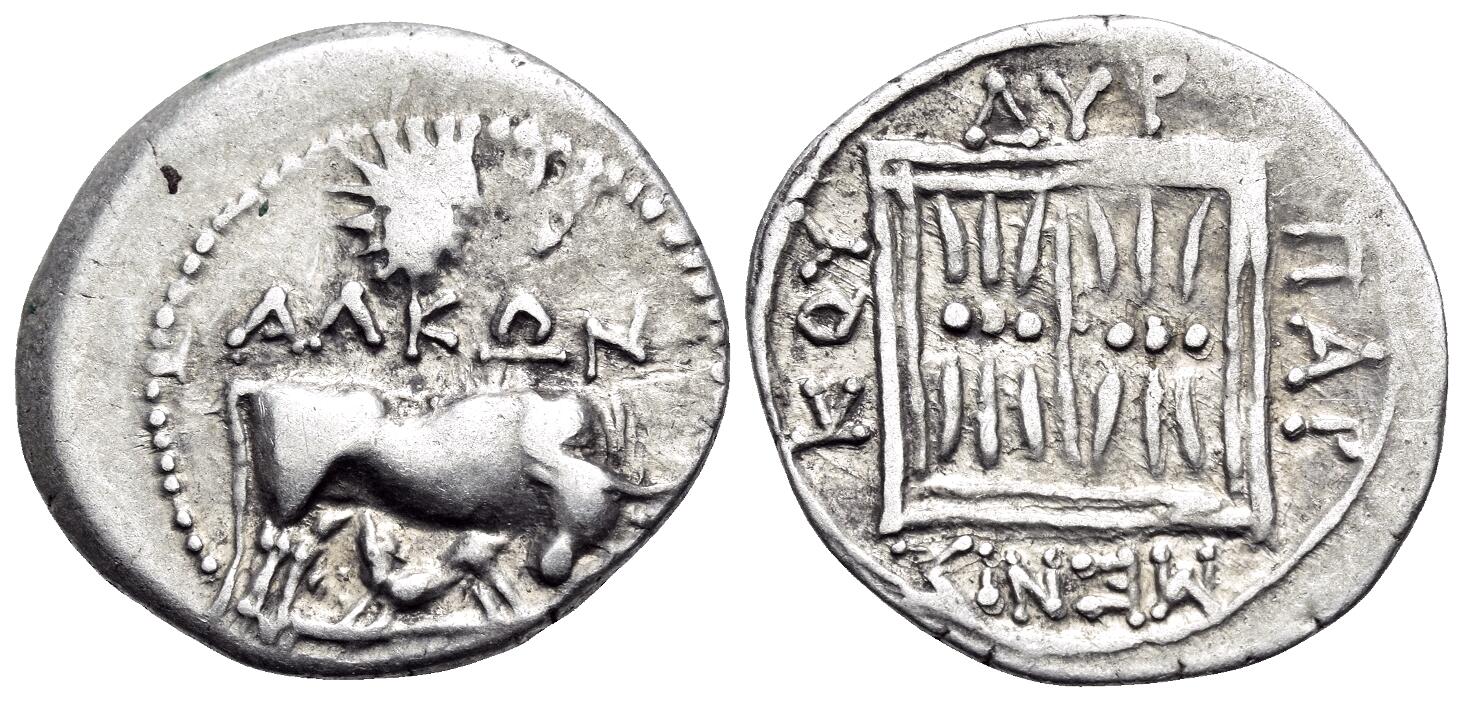S 1437 - Dyrrhachium, silver, drachms (120-70 BCE)
From SILVER
120 BCE - 70 BCE Silver 68,682 kg
Description
| ObverseInscription or printing placed on the obverse.: | Cow standing right, head turned to nudge suckling calf standing left below, above, radiate head of Helios facing |
| ReverseInscription or printing placed on the reverse.: | ΔYP ΠΑΡ-ΜΕΝΙΣ-ΚΟΥ (Greek).Double stellate pattern within double linear quadrangle |
Mint and issuing power
| MintIdentifies the place of manufacture or issue of a numismatic object.: | Dyrrhachium | Ancient regionAncient region.: | Illyricum | Modern countryModern country: Albania | AuthorityIdentifies the issuing power. The authority can be "pretended" when the name or the portrait of X is on the coin but he/she was not the issuing power. It can also be "uncertain" when there is no mention of X on the coin but he/she was the issuing power according to the historical sources: |
Chronology
| FromIdentifies the initial date in a range assigned in a numismatic context. | 120 BCE | toIdentifies the final date in a range assigned in a numismatic context.. | 70 BCE | PeriodTime period of the numismatic object.: Hellenistic 323-30 BC |
Physical description
| MetalThe physical material (usually metal) from which an object is made.: | Silver |
Median weightMedian of the weights of numismatic objects (in grams). in grams | 3.30 | DenominationTerm indicating the value of a numismatic object. Examples: tetradrachm, chalkous, denarius.: | drachma |
StandardStandard.: |
Image

S1437 Dyrrachium A120-70.jpg [1]
References
| Die study referencePublication of the study: | Meta 20151Meta 2015, p. 61-130 (Series III, Phase IV) | ||
| Coin series referenceReference to coin series study: | |||
Obverse dies distribution
| FrequencyFrequency of specimen in distribution. ᵖ | Number of obversesNumber of obverse dies. ᵖ (o) | % (o) | Number of coinsNumber of coins. (n) | % (n) | Die nameName(s) of the die(s). |
| 1 | 324 | 63.91 | 324 | 38.8 | |
| 2 | 103 | 20.32 | 206 | 24.67 | |
| 3 | 46 | 9.07 | 138 | 16.53 | |
| 4 | 18 | 3.55 | 72 | 8.62 | |
| 5 | 6 | 1.18 | 30 | 3.59 | |
| 6 | 7 | 1.38 | 42 | 5.03 | |
| 7 | 2 | 0.39 | 14 | 1.68 | |
| 9 | 1 | 0.2 | 9 | 1.08 | |
| Total | 507 of 507 | 100 | 835 of 835 | 100 |
Reverse dies distribution
no distribution is available
Quantification
| Number of obversesNumber of obverse dies. ᵖ (o) | 507 | Number of singletons (o1)The number of singleton coins. ᵖ | 183 |
| Number of reverse diesNumber of reverse dies. (r) | Number of coinsNumber of coins. (n) | 835 | |
| Coins per obverse dieNumber of coins per obverse die. (n/o) | 1.65 | Coins per reverse dieNumber of coins per reverse die. (n/r) | |
| Reverse per obverse ratioRatio of obverse dies divided by reverse dies. (r/o) | Percentage of singletons (o1)number of coins (n) divided by the number of singletons (o1) ᵖ | 36.09 % | |
| Original number of dies (O) (Carter 1983 formula)The estimation of the number of coins according to Carter 1983 ᵖ | 1040.64 | Coins struck if 20,000 as average productivity per dieCoins made if the average productivity for obverses (according to Carter) is 20,000. ᵖ | 20,812,800 |
| Original number of dies (O) (Esty 2011 formula)The estimation of the number of coins according to the singleton formula in Esty 2011 ᵖ (O) | 1290.69 | Survival rate if 20,000 as average productivity per dieSurvival rate if average productivity is 20,000. ᵖ | 0.00004 |
| Coverage (o = % of O) (Esty 1984 formula)Esty 1984 - coverage (% of O) ᵖ (o = % of O) | 78.08% | Die productivity if survival rate 1/2,000Average productivity if survival rate is 1/2,000. ᵖ | 1,604.78 |
| Weight of silver (in kg) if 20,000 coins per die (O = Carter formula)Carter 1983 * Median weight * 20000 (*10 if gold or electrum) ᵖ | 68,682 kg <br /> 68,682 kg | Die productivity if survival rate 1/5,000Average productivity if survival rate is 1/5,000. ᵖ | 4,011.95 |
Remarks